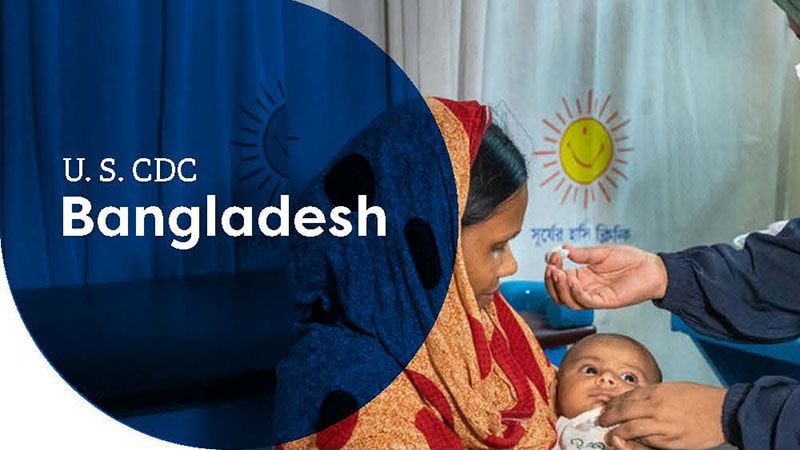At a glance
In collaboration with Bangladesh's Ministry of Health and Family Welfare (MOHFW) and other partners, CDC focuses on disease surveillance, laboratory systems, workforce development, emergency preparedness and response, One Health, and more. CDC-supported achievements include strong surveillance systems for numerous diseases, effective outbreak response, elimination of Lymphatic Filariasis, combating antimicrobial resistance, immunization research, and ensuring safe water access for Rohingya refugees.

Overview
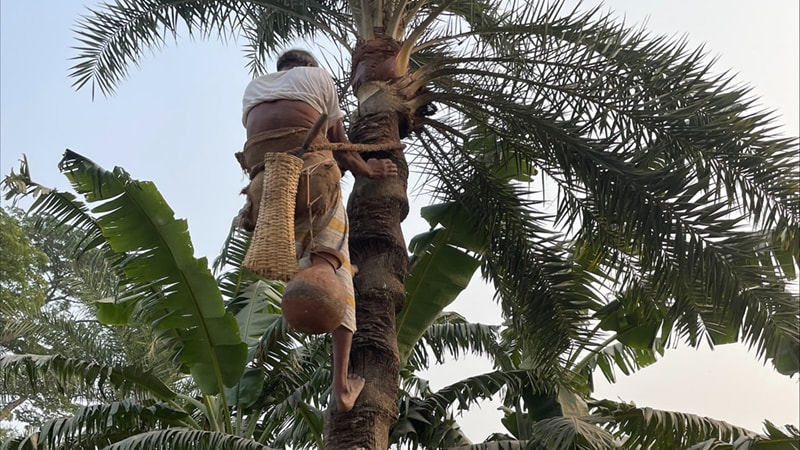
CDC has worked in Bangladesh for the past 50 years and established a permanent office in Dhaka in 2003. CDC Bangladesh works closely with the MOHFW's Institute of Epidemiology Disease Control and Research (IEDCR), Ministry of Fisheries and Livestock (MOFL), International Centre for Diarrhoeal Disease Research, Bangladesh (icddr,b), and other partner organizations to address public health areas, including:
- Disease surveillance
- Laboratory systems
- Workforce development
- Emergency preparedness and response
- Respiratory viruses
- One Health
- High-consequence pathogens
Global health security
Strategic focus
CDC's global health security work in Bangladesh focuses on strengthening the country’s public health systems across the following core areas:
Disease surveillance
For the past 20 years, CDC has worked with partners to build and strengthen surveillance systems for priority diseases and conditions such as SARS-CoV-2, influenza, avian influenza, Nipah virus, antimicrobial resistance, anthrax, rabies, dengue, acute febrile illness (AFI), and leptospirosis. CDC's efforts to strengthen surveillance systems help the country identify new pathogens, track, rapidly detect, and respond to health threats.
Laboratory systems
CDC provides ongoing training and technical support, as well as reagents for diagnostic, outbreak, and surveillance testing. For example, CDC helped establish serology and molecular diagnostics including real-time PCR, genomic sequencing methods, and bioinformatics abilities. CDC also helps partners develop and update the National Laboratory Policy and National Laboratory Strategic Plan. CDC-supported quality assurance programs also help laboratories ensure their testing is accurate and efficient. To protect laboratory staff, CDC provides trainings on biosafety and biosecurity and strengthens local abilities to certify biosafety cabinets.
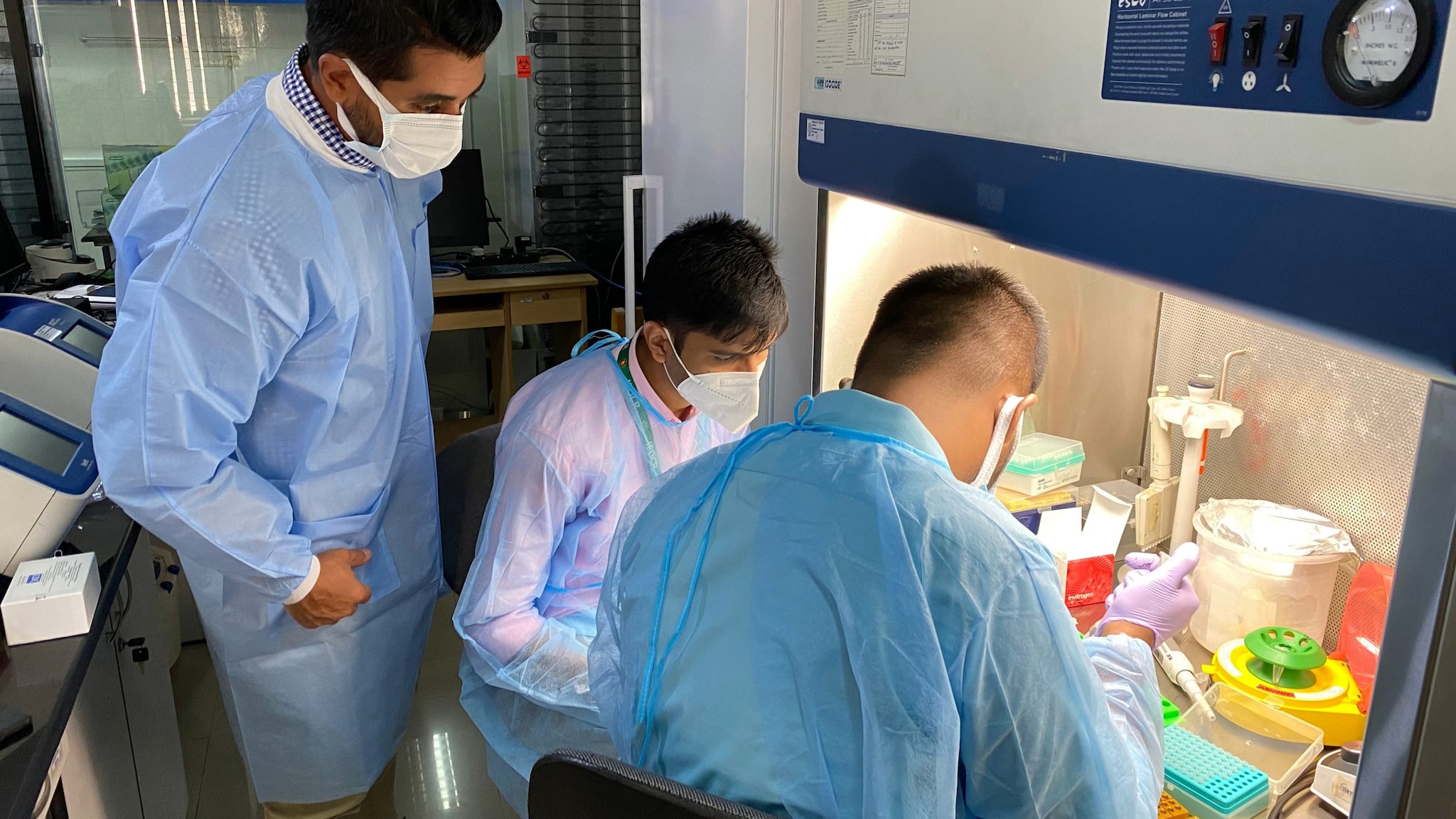
Workforce development
Several CDC-supported training efforts help strengthen the Bangladesh workforce’s abilities to conduct effective public health functions that keep people safe from diseases.
In partnership with the IEDCR and MOHFW, CDC established and continues to support three levels of the Field Epidemiology Training Program (FETP). Through FETP, CDC and partners train health professionals in disease surveillance, outbreak investigation, public health research, program evaluation, communication, and epidemiology.
CDC partners with the icddr,b to train hospital workers in infection prevention and control to prevent the spread of disease among patients and workers.
CDC's National Public Health Institute (NPHI) Program provides technical support within the Data Impact Program (DIP). Since 2018, the DIP and IEDCR have trained 138 participants to produce the national Public Health Bulletin, enhance scientific communications and manuscript writing, and generate policy briefs to inform health policy.
Emergency preparedness and response
CDC, IEDCR, and the MOHFW strengthen public health emergency preparedness, management, and response. CDC offers support and training to the national public health emergency operations center at IEDCR. This center is directly linked to national rapid response teams, which collaborate with the FETP to investigate disease outbreaks and respond to public health emergencies.
Key achievements
- With CDC support, surveillance data for multiple conditions are routinely shared publicly on Bangladesh government websites.
- A majority of FETP graduates remain in government agencies and continue to work in health.
- More than 45 trainees have completed Bangladesh’s FETP-Advanced since 2013.
- Since 2016, more than 200 have graduated from FETP-Frontline.
- In 2022, 16 trainees participated in the first FETP-Intermediate cohort.
- More than 45 trainees have completed Bangladesh’s FETP-Advanced since 2013.
- CDC and partners trained nearly 5,000 healthcare providers in infection prevention and control during the COVID-19 pandemic.
- This work continues to help minimize the spread of disease within healthcare facilities.
- This work continues to help minimize the spread of disease within healthcare facilities.
- For the first time, CDC trained 12 epidemiologists who work in major urban areas that are not part of the traditional MOH coverage areas.
- These epidemiologists filled a critical staffing gap as they lead screening activities, health campaigns, and responses to pressing local health issues like dengue.
- These epidemiologists filled a critical staffing gap as they lead screening activities, health campaigns, and responses to pressing local health issues like dengue.
- CDC helped protect the Rohingya refugee population and surrounding host community from COVID-19 through early community awareness campaigns on prevention and transportation of vaccines.
Respiratory viruses
Strategic focus
CDC and partners conduct surveillance for influenza, SARS-CoV-2, and other respiratory viruses across the general population, hospitals, and live bird markets. Since the National Influenza Center was established in 2007, CDC has supported IEDCR and icddr,b to operate nationwide respiratory virus surveillance. This system contributes to WHO’s Global Influenza Surveillance and Response System. It also informs vaccine strain selection for global influenza vaccine manufacturing, and tracks influenza, COVID-19, and other respiratory pathogens. CDC also supports laboratory strengthening, workforce readiness, outbreak investigations, emergency management, and pandemic preparedness.
Research efforts include:
- Developing and evaluating surveillance and diagnostic methods for respiratory diseases.
- Estimating how diseases effect mortality and morbidity, also known as disease burden, through enhanced surveillance.
- Studying uptake of seasonal influenza vaccines and cost effectiveness of vaccines among healthcare workers and other groups with higher risk of serious illness.
- Estimating the impact of the COVID-19 pandemic on routine immunization in Bangladesh.
One health
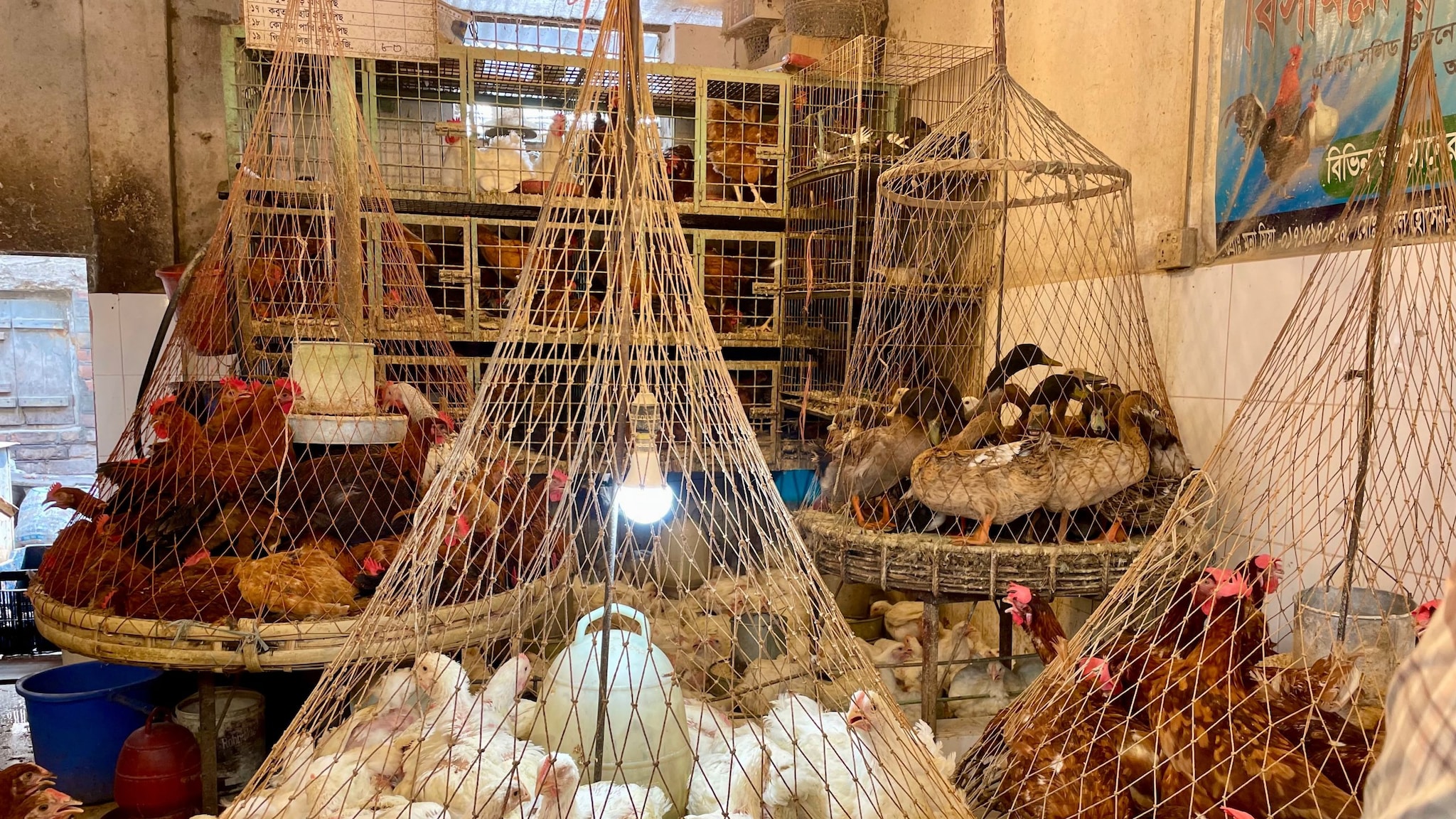
Strategic focus
CDC partners with scientists, veterinarians, and physicians to implement a One Health approach to prevent, detect, and respond to diseases that affect both animals and humans. In Bangladesh, the One Health approach is implemented for anthrax, avian influenza (bird flu), rabies, Nipah virus, melioidosis (Whitmore's disease), and dengue. Participants in the FETP-Veterinary track are trained through classroom sessions, mentoring, and projects with the Bangladesh Livestock Research Institute (BLRI) and Department of Livestock Services (DLS).
CDC supports One Health strategies, including:
- Conducting disease surveillance for new strains of influenza among poultry workers, live bird markets, and nomadic waterfowl.
- Conducting environmental studies to determine the distribution and genetic diversity of Burkholderia pseudomallei, a bacterium in soil and water that causes melioidosis.
- Enhancing safety measures for slaughtering and raising poultry in rural villages.
- Enhancing hygiene measures throughout the production chains of informal and formal markets that sell aquatic animals and plants.
- Determining effective, culturally acceptable ways to prevent spread of anthrax from deceased livestock.
- Using surveillance data to monitor circulating strains of bird flu, controlling outbreaks among poultry, and sharing genetic data with WHO to inform avian vaccine candidate selection.
Key accomplishments
- CDC supports bird flu surveillance in live bird markets. This is the only surveillance platform that monitors circulating influenza viruses in poultry.
- CDC-trained FETP-Veterinary program graduates continue to work in public health roles in the public sector in Bangladesh.
High-consequence pathogens
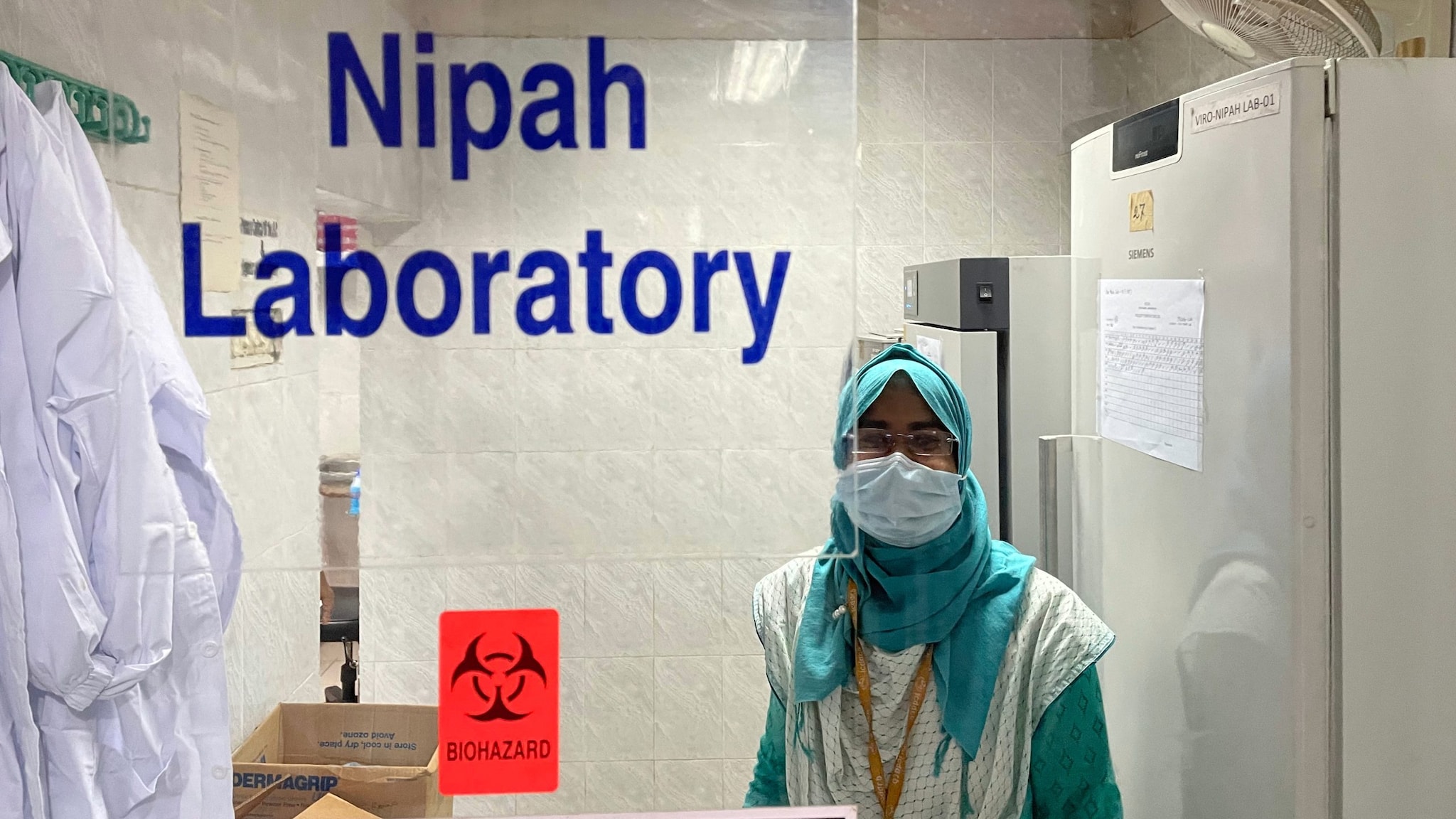
Strategic focus
CDC supports passive, enhanced, and active surveillance for infections caused by high-consequence bacterial and viral pathogens such as Bacillus anthracis (anthrax), Burkholderia pseudomallei (melioidosis), and Nipah virus. CDC has partnered with IEDCR and icddr,b to investigate and respond to Nipah virus disease outbreaks since the first identified outbreak in 2001. CDC has supported both partners with molecular and serological diagnostics and helped establish testing capabilities. CDC also trains staff both in-country and in Atlanta. CDC research projects and surveillance are critical to increasing experts' understanding of these pathogens and how to control them.
Key accomplishments
- Since 2007, CDC has supported surveillance, outbreak response, and training for Nipah virus.
- This strong surveillance support allows health officials to follow-up with Nipah virus disease survivors to better understand persistent infection and long-term effects of the virus.
- This strong surveillance support allows health officials to follow-up with Nipah virus disease survivors to better understand persistent infection and long-term effects of the virus.
- CDC’s support for broad Nipah surveillance helps increase understanding of the disease spread throughout the country and the potential for year-round transmission.
- CDC supports eight medical college hospitals through active surveillance, two district hospitals through passive surveillance, and more than 400 hospitals nationwide through enhanced surveillance.
- CDC, icddr,b, and Stanford, Vanderbilt, and Harvard universities are working to characterize the immune response from Nipah virus survivors and develop life-saving therapeutics.
- CDC supports research to understand the clinical aspects of melioidosis and its resistance to antibiotics in Bangladesh.
Dengue

In 2023, CDC responded to Bangladesh’s worst dengue season on record. CDC's dengue experts provided:
- Clinical, laboratory, and analytical support.
- Recommendations to strengthen clinical management of cases.
- Training to laboratory staff.
- Reagents for laboratory testing.
- Data analysis and training on epidemiological modeling, which helps experts understand how dengue spreads through populations.
CDC continues to support dengue prevention, planning, and response efforts.
Lymphatic filariasis
In May 2023, Bangladesh announced the elimination of lymphatic filariasis (LF), a painful and disfiguring neglected tropical disease. With this announcement, Bangladesh became the 18th country to achieve WHO validation of LF elimination. CDC supported post-treatment surveillance and continues to support post-validation surveillance to monitor for recurrence.
Vaccine-preventable diseases
CDC and partners conduct vaccine research and development, which produces data that inform health authorities' decisions related to childhood immunizations. For example, results of CDC’s research efforts informed policy decisions about introducing rotavirus vaccines into the country’s Expanded Program for Immunization.
CDC also supports polio vaccine trials. This work contributed to Bangladesh’s achievement of polio-free status and the global effort to eradicate the disease.
CDC continues to strengthen local abilities to generate evidence for sustained use of the pneumococcal conjugate vaccine and to assess current pneumococcal strains circulating in Bangladesh.
Antimicrobial resistance (AR)
Through CDC's Global Antimicrobial Resistance Laboratory and Response Network, CDC partners with IEDCR, BLRI, DLS, and icddr,b to study the impact, epidemiology, and drivers of AR in community and healthcare settings. Based on AR surveillance in the veterinary sector, DLS organized countrywide workshops to educate farmers on appropriate use of antibiotics. Findings from ongoing studies will inform understanding of new AR threats and enhance tailored prevention strategies across the globe. CDC also tracks and studies the Candida auris fungus, which is often multidrug-resistant, difficult to identify, and can cause deadly outbreaks.
Water, hygiene, and sanitation
Experts from across CDC helped develop centralized, chlorinated water systems in Cox's Bazar to ensure that Rohingya refugees have access to safe and clean water. CDC assessed chlorination coverage and implemented a bucket chlorination monitoring system that uses mobile phone surveys to ensure the presence of chlorinators, correct dosing of containers, and the presence of chlorine in household-stored water.
Key accomplishments
- In 2023, CDC partnered with Google in Bangladesh to link the public to reliable information on dengue from the Ministry of Health, UNICEF, and WHO. The use of Google and YouTube online platforms boosted views of public service announcement videos on dengue from fewer than 100 to nearly 10,000 per day.
- CDC partnered with researchers from the University of Virginia to study outcomes of Shigella (a bacteria that causes diarrhea, fever, and stomach cramps) infections among patients who were treated in Bangladesh. Results helped inform global clinical guidelines for using azithromycin, an antibiotic, to treat patients infected with Shigella.
- Since 2021, CDC has screened for Candida auris in two hospitals in Dhaka to monitor the prevalence of colonization among patients in intensive care units.
- CDC collaborates with WHO SEARO for assessments and reviews of public health investments. This includes the National Measles and Rubella Laboratory, FETP, and vaccine adverse event reporting systems.

